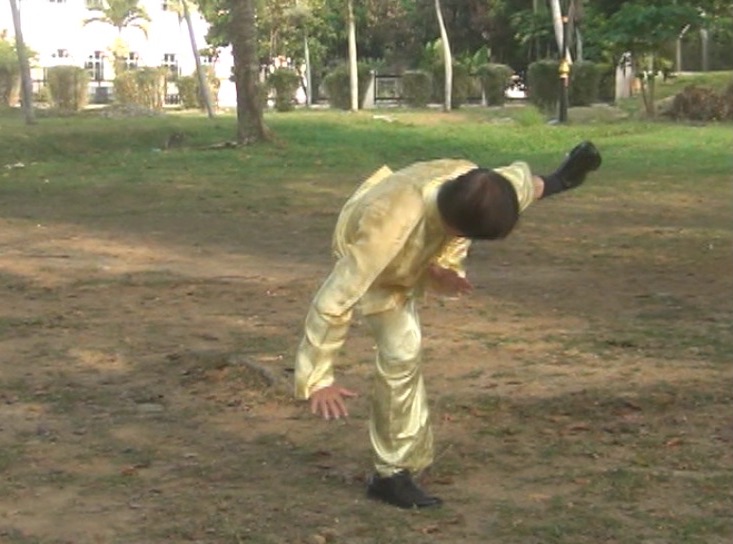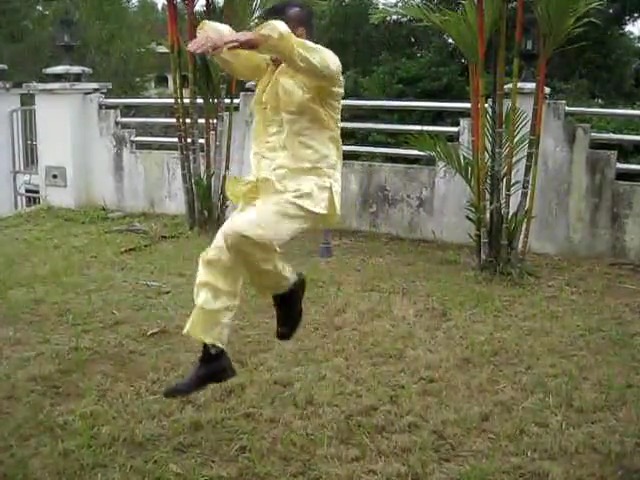36-PATTERN, 72-PATTERN AND 108-PATTERN SETS OF TIGER-CRANE

This pattern, "Lazy Tiger Stretches Waist", which incorporates the deadly tiger-tail kick found in the 36-pattern set, is surprisingly not found in the 108-pattern set
Question 12
The 36-pattern Tiger Crane can be traced back to the Venerable Harng Yein. You also mention that the 72-pattern Tiger Crane Set is traceable back to the famous Shaolin nun Ng Mui. Ng Mui was especially known to be an expert in the Flower Set. Can you please tell us more about the 72-pattern set and its connection to Ng Mui?
What are the main differences between the 36/72/108 pattern Sets besides the fact that they are different in the number of patterns?
Sifu Roland Mastel
Answer
At first I was quite surprised when I learned there was a Tiger-Crane Set in Choe Family Wing Choon. I thought that the Tiger-Crane Set was exclusive to Hoong Ka, though I called the school Shaolin at that time, and also now.
Of the Shaolin five animals, the Snake and the Crane were most prominent in Wing Choon Kungfu. In the Wing Choon 72-pattern Tiger-Crane Set, there were tiger claws but no crane beaks. The crane was represented in the palm and arm movements as well as in kicks. Wing Choon tiger claw, however, was unlike Hoong Ka tiger claw. Wing Choon tiger claw was more like eagle claw.
The Flower Set was found in both Uncle Righteousness’ school and in Sifu Choe Hoong Choy’s school, but they were different. In the Flower Set of Uncle Righteousness, the dragon was prominent. In the Flower Set of Sifu Choe Hoong Choy, the snake was prominent. The crane was found in both sets, but more prominently in Sifu Choe Hoong Choy’s set.
There were a lot of similarities between the Flower Set and the Tiger-Crane Set of Choe Family Wing Choon. For example, the techniques of Breaking Flank and of Horizontal Hand Sweep as well as the deadly Single Leg Flying Crane were found in both sets. With hindsight, I could conclude that both sets were taught by the famous Venerable Ng Mui.
On the other hand, there was not much difference between the Flower Set and the Tiger-Crane Set in Uncle Righteousness’ school. The prominent animal in the Uncle Righteousness’ Flower Set was the dragon, whereas the prominent animals in the Tiger-Crane Set, of course, were the tiger and the crane. One could easily see the difference between these two sets in Uncle Righteousness’ lineage. But leaving asides that the routine of the patterns was different, at a glance one may even think that the Flower Set and the Tiger-Crane Set in Choe Family Wing Choon were the same set!
At first I did not pay much attention to the combat application of the pattern, Single Leg Flying Crane, in Choe Family Wing Choon, though the pattern was very impressive to watch. But this view changed drastically after my free sparring with a Ng Mui master.
The Ng Mui master and I were talking about the 36 Kicks in Shaolin Kungfu. He told me that he knew only 35 because his master kept the last kick from him, and asked me if I could show him the 36th kick. I did. It was the hook-spring leg.
He said that he was still very grateful to his master as his master taught him an ultimate technique, against which no one could defend whenever he used it. I said that in Shaolin philosophy every attack could be defended. Eventually we ended up in free sparring.
His ultimate technique was a double attack to the eyes with a simultaneous double flying kick executed all in the air, manifested in the pattern, Single Leg Flying Crane. As I knew this attack, I could not only avoid it but also turn it back on him. He was very surprised.
The Ng Mui master showed me some kungfu patterns. Except for Siu Lin Tou, these patterns he demonstrated were similar to Choe Family Wing Choon patterns, confirming what Yim Wing Choon learned them from her teacher, Ng Mui, but later modified them to compose Siu Lin Tou to suit her own situation. Ng Mui patterns were just like our Shaolin patterns minus the masculine aspects of the drgaon, tiger and leopard. However, I did not ask him the names of established sets in Ng Mui Kungfu.
Of the three Tiger-Crane sets I have learnt, the 36-pattern set from Uncle Righteousness has the most number of tiger and crane patterns. This is interesting. It is the shortest of the three sets, yet has the most patterns of the Shaolin animals named for the set. It is because almost all the patterns in the set, including the signature Shaolin greeting at the start and the end, are tiger or crane patterns.
I would guess that if the 72-pattern Tiger-Crane Set from Choe Family Wing Choon is demonstrated, many people may not find any obvious tiger and crane patterns! This is because they associate tiger and crane patterns with what they see in Hoong Ka Kungfu, which is most famous for the tiger and the crane. In the same way, if Choe Family Wing Choon is demonstrated, many people may think it is not Wing Choon Kungfu because they associate Wing Choon Kungfu with Yip Man’s Wing Choon which is most famous today.
The tiger patterns in Choe Family Wing Choon are unlike the tiger patterns in Hoong Ka Kungfu. Wing Choon tiger claw is more like eagle claw, and it is more for grabbing than for separating tendons, dislocating joints and gripping energy points. There are also not many tiger claw, in its eagle claw version, in the set.
Most of the patterns in the 72-Pattern Tiger-Crane Set from Choe Family Wing Choon are crane patterns. But there are no crane beaks. So those accustomed to Hoong Ka’s crane patterns with their typical crane beak may wrongly think there are no crane patterns in this 72-pattern Tiger-Crane Set. Wing Choon crane patterns are characterized by movements of palms and arms, which represent the wings of a crane. There are also inauspicious kicks, except the spectacular kicks from Single Leg Flying Crane.
It is worthy of note that the Single Leg Flying Crane pattern in the Wing Choon set is different in its performance in the set than the Single Leg Flying Crane pattern in the Hoong Ka sets. Single Leg Flying Crane is similarly performed in the 36-pattern set and the 108-pattern set, with two arms at the sides, not in crane-beak form but in open palms with the thumb separately open, and an organ-seeking kick below while standing on one leg. The impression one gets is to open an opponent’s two arms with a gentle grip on top, while kicking his groin below.
Single Leg Flying Crane in Choe Family Wing Choon is spectacular, and it demands much skill to perform it correctly. Despite its name, an exponent is not standing on a single leg. In fact he is not standing on any leg. He is flying in the air with the fingers of his two palms thrusting into an opponent’s eyes, while double kicking his groin below. It is an attack that often catch an opponent by surprise. Even if he is not surprised, it is not easy for him to avoid the tricky multiple attacks of this pattern.
I reckon that the combat application of Single Leg Flying Crane in Hoong Ka Kungfu was originally like that in Wing Choon Kungfu. That was also how Hoong Man Ting, the son of Hoong Hei Khoon, defeated Pak Mei when he and his kungfu brother, Chow Yein Kit, killed Pak Mei to avenge the death of their sigung, Chee Seen, during the burning of the southern Shaolin Temple on Nine-Lotus Mountain. (In a Hong Kong movie, it was shown differently that Hoong Man Ting climbed up onto Pak Mei’s shoulder to strike his bai-hui energy point.) But later Hoong Ka masters camouflaged this deadly move in its present pattern. But as Choe Family Wing Choon is exclusive, taught only to selected students, this secret is still maintained.
Paradoxically, while the 108-pattern set is the longest of the three Tiger-Crane sets, it has the least tiger and crane patterns. This is because many of the patterns in the set are from Lohan Kungfu, on which the set is based. Surprisingly too, the tiger-tail kick, which is an important part of the no-shadow kick, is not found in this set (but is found in the Taming-Tiger Set).
An interesting feature is the use of the phoenix-eye fist in this set in the patterns, Left Crane Thrust Technique and Right Crane Thrust Technique. The phoenix-eye fist is not found in the 36-pattern set or any set in Uncle Righteousness’s school, but frequently found in the 72-pattern set and many other sets in Choe Family Wing Choon. It is a very effective hand form for striking energy points.
Eighteen Lohan Fist, which evolved from Eighteen Lohan Hands, was the prototype of Shaolin kungfu sets. A lot of Lohan patterns are found in the 108-pattern set, but not in the 36-pattern set except for 2 patterns, and not in the 72-pattern set.
Lohan patterns are powerful and hard. They are very useful for pressing against an opponent. Of the three Tiger-Crane Set, the 108-pattern set is the hardest, the 36-pattern set the next, and the 72-pattern set the softest.

This is the deadly double flying kick of "Single Leg Flying Crnae" found in the 72-pattern set
The questions and answers are reproduced from the thread Legacy of Wong Fei Hung Q-A Series by Sifu in the Shaolin Wahnam Discussion Forum.
LINKS
